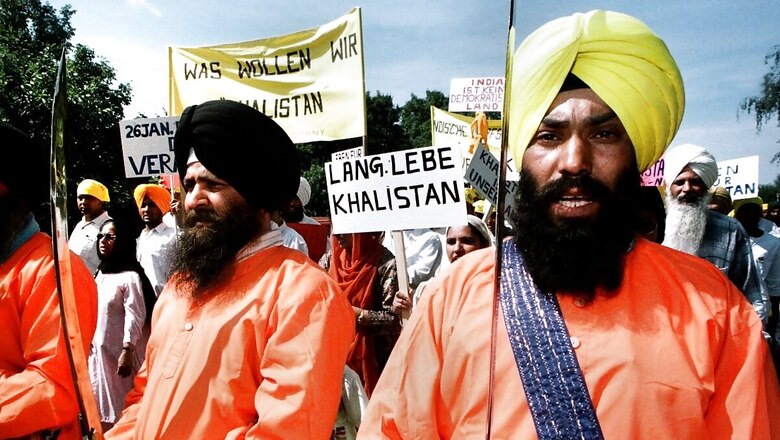
views
Punjab, during the period of ‘Green Revolution’, was the most prosperous state of India. The state, which went through almost 15 years of a painful insurgency from 1980, is once again facing unsurmountable challenges which emanate from political, economic, social and strategic reasons. If not handled maturely, they have the potential to take the state to another bout of chaos and turmoil. Having experienced the previous period of violence and turmoil in the 80s and 90s, one shivers at the thought of history repeating itself so soon. I recollect a few incidents of the late 70s and early 80s when I was a young officer who followed events in Punjab closely, even when I was posted to places as far away as Arunachal Pradesh, because I hailed from Punjab.
The first incident relates to, when I had once come home on leave. I saw a big poster on a wall reading “Sikh Homeland Lai Ke Rahenge” which meant “We will take Sikh Homeland”. I laughed at the idea, thinking in my mind that no right-thinking Sikh of Punjab would ever buy such a bizarre idea. I thought the people of Punjab were too busy in their economic activities to pay heed to such ideas. By 1984, I realised how wrong I was. Besides the internal political games played by politicians, propaganda supported by external forces inimical to India could sway young minds and create havoc in a sensitive border state like Punjab. Rest is a painful part of history.
The second occurrence was an open letter written to Indira Gandhi, the then prime minister, by the famous journalist Khushwant Singh, which I read in a national newspaper. The letter requested her and her party not to play with fire or take those developments in a border state like Punjab lightly. I don’t think the political leadership of the time took that open letter of Khushwant Singh seriously or else the state would not have gone through the cycle of violence and bloodshed.
As per official estimates, 20,000 people were killed during the Punjab conflict, including 11,690 civilians, 1714 policemen and 7,946 militants. Many more are still missing, suspected to be victims of enforced disappearances perpetrated by the police. The biggest loser was the common man of Punjab, irrespective of his/her religion or caste. The negative economic impact of that period is still being felt by the people of the state. Whatever industry existed in the border state, shifted out to the neighbouring states or NCR, which took the jobs along leaving the youth dependent primarily on agriculture in an era of shrinking land holdings.
Having witnessed the entire saga as it unfolded from the late 70s to the restoration of normalcy in the mid-90s, it is strongly felt that the whole episode is unfolding in a similar manner once again. Unfortunately, history appears to be repeating itself too soon and the stakeholders don’t seem to have learnt their lessons. The political fault lines are reappearing and the state is being used as a playground to play political games. Recent incidents of violence and subsequent poor performance of the police highlight an all-round failure of the leadership and the administration. These incidents could not have been planned and executed overnight. An alert police and the administration could have easily anticipated and prevented such incidents. Someone in the executive must shoulder responsibility for the serious unacceptable lapses. Blaming the ISI of Pakistan is a fair judgement, but we would be too naive not to expect our adversaries to take advantage of our fault lines, especially if we offer them on a platter. The solution lies in putting our own house in order and not just blaming the adversaries.
The current national security environment is far too volatile and challenging due to enhanced threat levels on our Northern borders and active collusion between China and Pakistan in every sphere possible, to threaten India. At this juncture, the country can ill afford another challenge in a sensitive strategically pivotal border state like Punjab. A peaceful security environment is a prerequisite for India’s economic growth to realise the dream of a five trillion-dollar economy.
It needs to be remembered that the restoration of peace in the 90s was the result of resolute political leadership of that time and the people of Punjab who supported the security forces and the administration. In fact, the people of Punjab decided to stand up against the militants helping the security forces in successfully executing operations in those days.
It is time to take the current threat seriously and take all possible steps to nip the problem in the bud before things get out of hand. The way forward, therefore, is — Firstly, the security apparatus must be beefed up to produce the highest quality of specific intelligence and targeted police operations to ensure an incident-free environment. There needs to be better coordination between the Central and state intelligence and security agencies. Secondly, steps must be taken to prevent the ill effects of Narco-terrorism due to the nexus between criminals and potential terrorists. Drug abuse by the youth needs to be checked by involving all stakeholders. Thirdly, the state needs investments and economic activity to create jobs and improve the quality of life of the citizens by reducing their dependence on agriculture. Last, but not the least, it is imperative that all political parties shed their differences to put up a united front against the nefarious designs of the potential terrorists and adversaries of the country so that the state does not slip into that dark phase once again. The time to act is NOW.
Lt Gen Balbir Singh Sandhu (Retd) was head of Army Service Corps. He is a distinguished fellow at United Service Institution of India. The views expressed in this article are those of the author and do not represent the stand of this publication.
Read all the Latest Opinions here


















Comments
0 comment